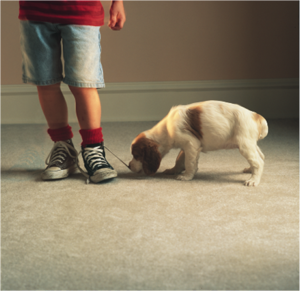Scotchgard & Fabric Protection
3M Scotchgard® Repels Dirt and Stains
 It’s always a pleasure to see how bright and clean your carpets look right after they’ve been professionally cleaned. Now you can keep them looking fresh and new longer by asking for Scotchgard® protection.
It’s always a pleasure to see how bright and clean your carpets look right after they’ve been professionally cleaned. Now you can keep them looking fresh and new longer by asking for Scotchgard® protection.
- Scotchgard® delivers its protection by forming a molecular shield around each carpet fiber. The shield lowers the surface energy of the carpet fibers causing them to repel liquid spills and dust and dirt. This helps prevent dirt and stains from being ground into or absorbed by the fibers.
- Scotchgard® uses technology to provide more repellency than any other carpet protector. It repels most liquids, allowing spills to be removed before staining and wicking can occur. Dirt and stains cling to untreated carpet and quickly become embedded in the fibers. Scotchgard® keeps dirt from sticking to the fibers, making carpets easier to care for.
- Scotchgard® must be professionally applied by your carpet cleaner. It is applied by spray application, dries quickly, and leaves no odor. It is non-toxic and safe to use around family and pets. It’s CFC- and solvent-free.
- 3M recommends the application of Scotchgard® after each cleaning on all carpet fiber types. With an application of Scotchgard® carpet protector, you have the assurance your carpet is protected with a premium quality product. The next time you have your carpets professionally cleaned, be sure to ask for Scotchgard® carpet protector.
Should I have carpet protector applied to my carpet?
Unfortunately, there is probably as much confusion in the carpet cleaning industry about carpet protectors as there is about cleaning. Carpet cleaners cause a great deal of confusion by giving out false information or intentionally misrepresenting the product. A nylon stain-resist carpet is made with two protective properties. The first is an acid dye blocker that is basically a clear dye that fills the extra dye sites in a fiber. This helps to keep “foreign” dyes (such as red dye in a beverage) from penetrating the carpet fiber. The second property is called a “fluorochemical”. It is commonly known as 3M Scotchgard®. This treatment helps keep spillage from actually getting to the acid dye blocker, but its biggest job is to resist dry soil. By resisting dry soil, less soil bonds to the carpet, therefore being picked up by your vacuum or cleaning. Making sure that you have a sufficient amount of protector on your carpet will help keep the soil from bonding to the carpet. Once it bonds to the carpet, it acts like sandpaper on your traffic area. Once the traffic area yarns are broken down, there is no way to bring them back to their original state.
 Two primary ways that factory protector is removed from a carpet:
Two primary ways that factory protector is removed from a carpet:
- Regular foot traffic. Over a period of 6 months to 2 years depending on traffic, abrasion, caused by regular foot traffic and vacuuming, will remove a significant amount of the protector and lower its effectiveness.
- High alkaline cleaner. Uneducated, carpet cleaners use harsh chemicals on the carpet that will strip it’s protection. If one of these rascals has been in your house, you may want to have the carpet re-protected.
Four Mistakes Other Cleaners Make In Applying Protector
- Not using high quality protector.
Discount protectors are not as effective and sometimes void the warranty of the carpet. ABC Carpet Cleaning uses only the highest quality, recommended protectors. We apply 3M Scotchgard® Protector - Not using a dedicated container.
Using the same container for carpet protector as other cleaners can contaminate the carpet protector making it gummy and ineffective. Our vans have a dedicated container reserved ONLY for carpet protector. - Not applying the product properly.
Some cleaners either under apply or over apply the protector. Under applying it doesn’t allow for complete penetration on the carpet yarns. Over applying it causes the carpet to become overly stiff and crusty. ABC Carpet technicians are diligently trained for proper application. - Not grooming the carpet.
For the best performance, the product should be groomed into the carpet for maximum penetration. This ensures contact with all surfaces of the carpet yarn and proper distribution and drying.
 Call For An Appointment
Call For An Appointment Professional Cleaning
Professional Cleaning Follow Up
Follow Up

